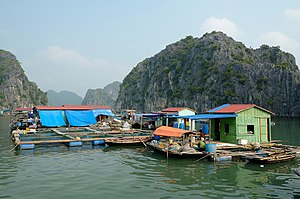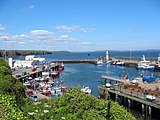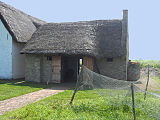Fishing village

A fishing village is a village, usually located near a fishing ground, with an economy based on catching fish and harvesting seafood. The continents and islands around the world have coastlines totalling around 356,000 kilometres (221,000 mi).[1] From Neolithic times, these coastlines, as well as the shorelines of inland lakes and the banks of rivers, have been punctuated with fishing villages. Most surviving fishing villages are traditional.
Characteristics[]

Coastal fishing villages are often somewhat isolated, and sited around a small natural harbour which provides safe haven for a village fleet of fishing boats. The village needs to provide a safe way of landing fish and securing boats when they are not in use.[2] Fishing villages may operate from a beach, particularly around lakes. For example, around parts of Lake Malawi, each fishing village has its own beach. If a fisherman from outside the village lands fish on the beach, he gives some of the fish to the village headman.[3] Village fishing boats are usually characteristic of the stretch of coast along which they operate. Traditional fishing boats evolve over time to meet the local conditions, such as the materials available locally for boat building, the type of sea conditions the boats will encounter, and the demands of the local fisheries.[citation needed]
Some villages move out onto the water itself, such as the floating fishing villages of Ha Long Bay in Vietnam, the stilt houses of Tai O built over tidal flats near Hong Kong,[4] and the kelong found in waters off Malaysia, the Philippines and Indonesia. Other fishing villages are built on floating islands, such as the Phumdi on Loktak Lake in India, and the Uros on Lake Titicaca which borders Peru and Bolivia.[citation needed]
Apart from catching fish, fishing villages often support enterprises typically found in other types of village, such as village crafts, transport, schools and health clinics, housing and community water supplies. In addition, there are enterprises that are natural to fishing villages, such as fish processing and marketing, and the building and maintenance of boats. Until the 19th century, some villagers supplemented their incomes with wrecking[5] (taking valuables from nearby shipwrecks) and smuggling.[6][7]

Po Toi O is a small active fishing village at Clear Water Bay Peninsula near Hong Kong

Port Isaac, a historic fishing village on the north coast of Cornwall
In less developed countries, some traditional fishing villages persist in ways that have changed little from earlier times.[8] In more developed countries, traditional fishing villages are changing due to socioeconomic factors like industrial fishing and urbanization.[9] Over time, some fishing villages outgrow their original function as artisanal fishing villages. Seven hundred years ago, Shanghai, beside the Yangtze River delta, was a small fishing village.[10] In recent times, fishing villages have been increasingly targeted for tourist and leisure enterprises. Recreational fishing and leisure boat pursuits can be big business these days, and traditional fishing villages are often well positioned to take advantage of this. For example, Destin on the coast of Florida, has evolved from an artisanal fishing village into a seaside resort dedicated to tourism with a large fishing fleet of recreational charter boats.[11] The tourist appeal of fishing villages has become so big that the Korean government is purpose-building 48 fishing villages for their tourist drawing power.[12] In 2004 China reported it had 8,048 fishing villages.[13]
Early villages[]

Skara Brae on the west coast of the Orkney mainland, off Scotland, was a small Neolithic agricultural and fishing village with ten stone houses. It was occupied from about 3100 to 2500 BC, and is Europe's most complete Neolithic village. The ancient Lycian sunken village of Kaleköy in Turkey, dates from 400 BCE.[14] Clovelly, a fishing hamlet north Devon coast of England, an early Saxon settlement, is listed in the Domesday Book.[15] Kaunolu Village, a Hawaiian fishing village, is thought to date from about 1500 CE.[citation needed]
Recent archaeological excavations of earlier fishing settlements are occurring at some pace. A fishing village recently excavated in Khanh Hoa, Vietnam, is thought be about 3,500 years old.[16] Excavations on the biblical fishing village Bethsaida, on the shore of the Sea of Galilee and birthplace of the apostles Peter, Philip and Andrew, have shown that Bethsaida was established in the tenth century BCE.[17] A Tongan fishing village, recently excavated, appears to have been founded 2900 years ago. This makes it the oldest known settlement in Polynesia.[18] Another recent excavation has been made of Walraversijde, a medieval fishing village on the coast of West Flanders in Belgium.[19]

Portofino, founded in Roman times, is a picturesque fishing village on the north west Italian coast.

Dunmore East in south east Ireland has been a busy fishing port for hundreds of years.

Pittenweem is a small and secluded fishing village on the east coast of Scotland, founded on historic herring fisheries.

Reconstructed smokehouse at the medieval fishing village of Walraversijde, ca. 1465
See also[]
- Artisanal fishing
- Community-supported fishery
- Fishing stage
- List of fishing villages
- Newfoundland outport
- Norwegian Fishing Village Museum
- Traditional fishing boat
Notes[]
- ^ CIA World Factbook Updated 9 April 2009.
- ^ Sciortino, J. A., Barcali, A. & Carlesi, M. (1995)Construction and maintenance of artisanal fishing harbours and village landings FAO Training Series 25, Rome.
- ^ FAO (1993) Fisheries management in south-east Lake Malawi Chambo Fisheries Research Project, Technical paper 21. Rome
- ^ Tai O Fishing Village
- ^ Bathurst, Bella (2005)The Wreckers: a Story of Killing Seas, False Lights, and Plundered Shipwrecks. Boston, Mass.: Houghton Mifflin ISBN 978-0-618-41677-6
- ^ Smith, Joshua M. (2006) Borderland Smuggling: Patriots, Loyalists and Illicit Trade in the Northeast, 1783–1820 Gainesville: University Press of Florida ISBN 0-8130-2986-4.
- ^ Waugh, Mary, (1985) Smuggling in Kent and Sussex 1700–1840 Countryside Books (updated 2003) ISBN 0-905392-48-5
- ^ Tietze, U., Groenewold, G. & Marcoux, A. (2000)Demographic change in coastal fishing communities and its implications for the coastal environment FAO Fisheries Technical Paper 403. Rome.
- ^ "The Effects of Urbanization and Social Orientation" (PDF). Retrieved 21 December 2008.
- ^ Shanghai was once a seaside fishing village Streetdirectory.com. Retrieved 20 April 2009.
- ^ History of the World’s Luckiest Fishing Village Archived 16 November 2007 at the Wayback Machine The Destin Area Chamber of Commerce. Retrieved 21 April 2009.
- ^ Henderson J C (2002) "Tourism and Politics in the Korean Peninsula"[permanent dead link] The Journal of Tourism Studies, 13 (2).
- ^ Zhijie G, Yingliang X, Xiangguo Z, Yong W, Daobo A and Sugiyama S (2008) Review of fishery information and data collection systems in China[permanent dead link] FAO Fisheries Circular No. 1029, p. 46. Rome. ISBN 978-92-5-105979-1.
- ^ Kekova-Simena Region LycianTurkey. Retrieved 21 April 2009.
- ^ Focus on Devon Archived 6 April 2009 at the Wayback Machine Ancient Tree Forum. Retrieved 21 April 2009.
- ^ Ancient fishing village unearthed in Vietnam Archaeo News.
- ^ Bethsaida- An Ancient Fishing Village on the shore of the Sea of Galilee, 2001, Israel Ministry of Foreign Affairs.
- ^ Tongan fishing village dated oldest in Polynesia Stuff.co.nz, 10 January 2008.
- ^ Tys D and Pieters M (2009) "Understanding a medieval fishing settlement along the southern Northern Sea: Walraversijde, c. 1200–1630" In: Sicking L and Abreu-Ferreira D (Eds.) Beyond the catch: fisheries of the North Atlantic, the North Sea and the Baltic, 900-1850, Brill, pages 91–122. ISBN 978-90-04-16973-9.
References[]
- Beare RJ and K E Rushoke (2001) Integrated Development of Fishing Villages in Kagera Region, Tanzania FAO, Rome.
- Belcher, W.R. (1999) The Ethnoarchaeology of a Baluch Fishing Village. Archaeology of Seafaring: The Indian Ocean in the Ancient Period, Himanshu Prabha Ray ed., pp. 22–50.
- Drewes, Edeltraud (2004) Three Fishing Villages In Tamil Nadu - A Socio-Economic Study With Special Reference To The Role and Status of Women FAO Working Paper BOBP/WP/14. Rome
- McGoodwin JR (2001) Understanding the cultures of fishing communities. A key to fisheries management and food security FAO Fisheries, Technical Paper 401. ISBN 978-92-5-104606-7.
- Poonnachit-Korsieporn A (2000) Coastal fishing communities in Thailand FAO: Regional Office for Asia, Publication 2000/06. Rome.
- Seilert H and S Sangchan (2001) Small-Scale Fishery in Southeast Asia: A Case Study in Southern Thailand: Social and geographic background Regional Office for Asia and the Pacific, Publication 2001/19, FAO, Rome.
- Seilert H and S Sangchan (2001) Small-Scale Fishery in Southeast Asia: A Case Study in Southern Thailand: Fishing activities and their social implications Regional Office for Asia and the Pacific, Publication 2001/19, FAO, Rome.
- Sciortino JA (1995) Construction and Maintenance of Artisanal Fishing Harbours and Village Landings Volume 25 of FAO Training Series, FAO, Rome. ISBN 9789251036099.
- Thomson, David B (1979) South China Sea Fisheries Development and Coordinating Programme Intermediate technology and alternative energy systems for small scale fisheries: Integrated systems FAO working paper, Rome.
External links[]
| Wikimedia Commons has media related to Fishing villages. |
- City vs.village fishing, Microdocs
- How to Save New England's Fishing Villages, ReasonOnline
- A Baluchi fishing village
- Teochow Fishing Village – China
- Seeb, Oman, a fishing village
- The Norwegian Fishing Village Museum
- History of Flakstad & Moskenes, Lofoten Islands
- Fishing Village Mumbai, India – video
- Fishing villages
- Types of village











